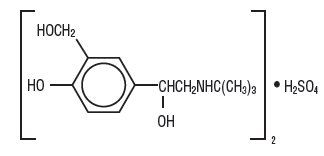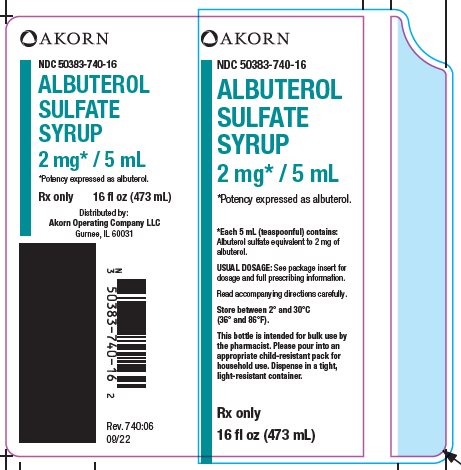Drug Catalog - Product Detail
ALBUTEROL SULFATE SYRUP SYR 2MG/5ML 473ML
| NDC | Mfr | Size | Str | Form |
|---|---|---|---|---|
| 50383-0740-16 | AKORN | 473 | 2MG/5ML | NA |
PACKAGE FILES


Generic Name
Substance Name
Product Type
Route
Application Number
Description
DESCRIPTION Albuterol Sulfate Syrup contains albuterol sulfate, USP, the racemic form of albuterol and a relatively selective beta 2 -adrenergic bronchodilator. Albuterol sulfate has the chemical name (±)α1-[( tert -butylamino) methyl]-4-hydroxy- m -xylene-a,a'-diol sulfate (2:1) (salt), and the following chemical structure: Albuterol sulfate has a molecular weight of 576.7 and the molecular formula (C 13 H 21 NO 3 )2 • H 2 SO 4 . Albuterol sulfate is a white or practically white powder freely soluble in water and slightly soluble in alcohol, in chloroform, and in ether per USP definition. The World Health Organization recommended name for albuterol base is salbutamol. Each 5 mL (teaspoonful), for oral administration contains 2.4 mg of albuterol sulfate equivalent to 2 mg of albuterol. Albuterol Sulfate Syrup also contains the inactive ingredients citric acid anhydrous, FD & C Yellow No. 6, hydroxypropyl methylcellulose, orange flavor, purified water, saccharin, sodium benzoate, and sodium citrate. The pH of the syrup is 3.5 to 4.5. Chemical structure
How Supplied
HOW SUPPLIED Albuterol Sulfate Syrup, a yellow-orange liquid with an orange flavor, contains 2 mg albuterol as the sulfate per 5 mL; bottles of 4 fluid ounces, 8 fluid ounces and 16 fluid ounces.
Indications & Usage
INDICATIONS AND USAGE Albuterol Sulfate Syrup is indicated for the relief of bronchospasm in adults and children 2 years of age and older with reversible obstructive airway disease.
Dosage and Administration
DOSAGE AND ADMINISTRATION The following dosages of Albuterol Sulfate Syrup are expressed in terms of albuterol base. Usual Dosage Adults and Children Over 14 Years of Age: The usual starting dosage for adults and children over 14 years of age is 2 mg (1 teaspoonful) or 4 mg (2 teaspoonfuls) three or four times a day. Children Over 6 Years to 14 Years of Age: The usual starting dosage for children over 6 years to 14 years of age is 2 mg (1 teaspoonful) three or four times a day. Children 2 to 5 Years of Age: Dosing in children 2 to 5 years of age should be initiated at 0.1 mg/kg of body weight three times a day. This starting dosage should not exceed 2 mg (1 teaspoonful) three times a day. Dosage Adjustment Adults and Children Over 14 Years of Age: For adults and children over 14 years of age, a dosage above 4 mg four times a day should be used only when the patient fails to respond. If a favorable response does not occur with the 4-mg initial dosage, it should be cautiously increased stepwise up to a maximum of 8 mg four times a day as tolerated. Children Over 6 Years to 14 Years of Age Who Fail to Respond to the Initial Starting Dosage of 2 mg Four Times a Day: For children over 6 years to 14 years of age who fail to respond to the initial starting dosage of 2 mg four times a day, the dosage may be cautiously increased stepwise, but not to exceed 24 mg/day (given in divided doses). Children 2 to 5 Years of Age Who Do Not Respond Satisfactorily to the Initial Dosage: For children from 2 to 5 years of age who do not respond satisfactorily to the initial starting dosage, the dosage may be increased stepwise to 0.2 mg/kg of body weight three times a day, but not to exceed a maximum of 4 mg (2 teaspoonfuls) given three times a day. Elderly Patients and Those Sensitive to Beta-adrenergic Stimulators: The initial dosage should be restricted to 2 mg three or four times a day and individually adjusted thereafter.
